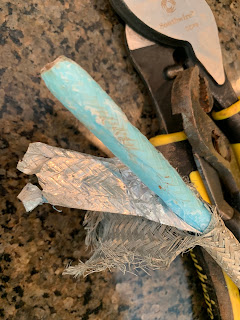Ground Noise on Astron Power Supplies
Not too long after acquiring an Elecraft KX3 and the PX3 panadapter, I experienced how useful having a real-time spectrum display was in tracking down noise problems. It's interesting that several local noise problems revealed were ones that for the most part were not audible, particularly on an HF band with expected atmospheric noise levels masking a good bit -- but seeing is believing. |
| Astron RS-35M -- 1990's |
Jim Brown, K9YC, published a white paper around an issue that sounded very similar to what I was seeing -- although he was initially validating that a transmit audio issue was being caused by a ground issue on the V- of some Astron supplies. Repeater-Builder.com has also compiled much information on this subject as well and can be found here.
To net it out, particular Astron supplies manufactured at certain times have bonded the V- (the negative/ black lead) output of the supply to the chassis, along with the "green wire" third pin on the standard AC plug. In other words, the supply as manufactured this way is not a floating DC supply -- and anything on the AC safety ground will make its way to the V- feeding your rig and accessories, potentially causing noise current to flow through things you'd rather it not flow through. Putting an ohmmeter from V- to the chassis will tell the story -- if there is something close to zero ohms, it is not floating.
 |
| RS-35M with Negative Bonded to Chassis |
In my case, checking the resistance revealed .006 ohms between the chassis and the negative terminal, so I cracked open the case to see how this was achieved. Simply, a black 16 gauge lead ran from the circuit board "ground" to a screw with star washers on the bottom of the chassis -- this was in parallel to another wire that went from the same solder pad to the V- terminal on the rear. (It is interesting that the V- terminal is actually insulated from the chassis, go figure) I disconnected the chassis wire, heat shrink wrapped the now disconnected terminal (if for some reason I wanted to reconnect later), and put the cover back together. Plugged it in, tested the voltage, powered up the KX3 / PX3 and -- No Noise.
Maybe this workhorse will be around the shack another 10 years!












